The Good Life – The Green Life features nine everyday green heroes from British Columbia’s south coast who are dealing with climate change in creative ways. Their stories and vision shaped the film and the ideas in it.
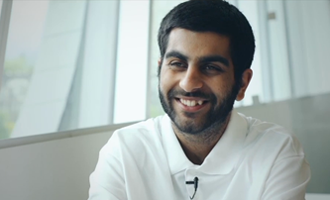 Puneet
Puneet
Delta
Puneet loves to get around on public transit and by foot. In fact, you’ll often find him running from one place to another – even all the way from his home to school, where he’s studying business. He also makes a point of taking the bus and skytrain. Puneet figures he’s already paying for public transit through his taxes, so it makes sense to use it – and he likes seeing people from all walks of life instead of being alone in a vehicle. Puneet believes a sustainable future means we need to build more compact communities, where shops and community services are close to where people live, and public transit is convenient and easy for everyone to use. Hear more about Puneet’s ideas for a good, green life in Chapter 1 and Chapter 2.
In the future I just see my area really well urban designed. Everything’s nearby. You don’t have to drive everywhere – not only myself, but for everybody. – Puneet
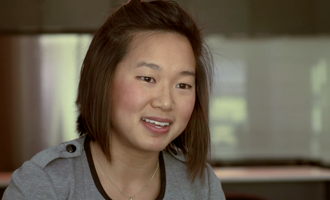 Tanya
Tanya
North Vancouver
Tanya lives in North Vancouver, at the foot of the mountains that border the region’s northern edges. She looks for ways to reduce her environmental footprint every day – like walking and carpooling, and reducing her consumption. But she recognizes that it’s impossible for anyone to be perfectly green all by themselves. She thinks education is a key part of how we shift gears as a society, and volunteers with a school program that teaches kids about where food comes from and how to grow gardens. You can hear more from Tanya in Chapter 2.
It’s probably not really a technical problem any more, because there is so much research out there that shows the impact of global warming and a lot of the things that we are doing to the environment. So, we have all the facts…It’s more of a social issue. – Tanya
 David
David
Surrey
David lives in Surrey, a large city in the Lower Mainland (or Metro Vancouver) area, with his wife and two young children. One of the key challenges facing Surrey is sprawl – housing and services are very spread out, and as with other municipalities in our region, transportation is largely designed around vehicles. But David and his wife chose to live in the Newton neighbouhood, which is more pedestrian friendly. With many shops, services and green spaces nearby, David says “we tend to park our car on the weekend” and make as few trips as possible through the week. David believes that dealing with climate change can lead to a better quality of life. He is also passionate about community – about helping to spark the conversations and connections that can help people solve problems locally. Hear more about David’s story in Chapter 3.
I think it’s really important that we look at what we stand to gain with this opportunity to reinvent and rethink and rebuild our world and our communities and I think there is huge potential for us to create something that is more connected, less stressful, more powered down, more healthier, more happier. – David
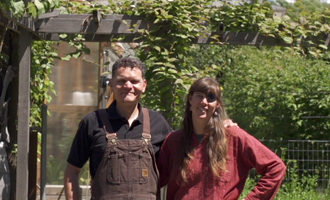 Carolyn and Thomas
Carolyn and Thomas
Squamish
Carolyn and Thomas are passionate about healthy, sustainable food – growing it, eating it, sharing it, and helping others learn about it. They live in the coastal town of Squamish on a typical-size property of just over an acre, where they grow most of what they eat. Both have day jobs – Thomas in construction, and Carolyn with the local farmers market. For them, a good life means being able to slow down the frantic pace of life enough to enjoy simple pleasures – like growing and eating delicious foods, and getting to know other people in their community. They believe slowing down the pace of everyday life—and the pace of our consumption—is a key part of building a sustainable future. You can hear more about their story in Chapter 4.
I love the concept of slowing down…To be able to connect with people, to take the time to say hello to people that we pass on the road. You know, there is such beauty in those connections, in our community all around us. – Carolyn
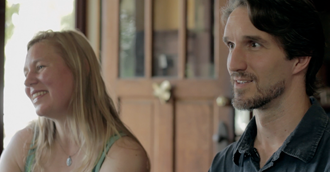 Leanne and James
Leanne and James
Maple Ridge
Leanne and James live with their two young kids in a historic area of Maple Ridge called Hammond, in the house Leanne’s grandfather built, not far from the large cedar mill where he worked. Like the many other older homes in the neighbourhood, their house isn’t very energy efficient. And as they found out when they decided to change that, retrofitting your home is expensive, and gets complicated quickly. Instead of everyone having to re-invent the wheel, they’re looking for ways to help whole neighbouhoods get on board, so retrofitting can be cheaper and easier. James and Leanne love connecting with people in their local area to share ideas and solve problems. Leanne works for the area’s recycling society, and thinks one of the most important things we can do is make environmentalism easy and fun. You can hear more about them in Chapter 5.
If you know people and you care about them, it just facilitates conversations, it facilitates things that really matter and things you really care about and it facilitate action if there’s something that everybody feels strong enough about. – Leanne
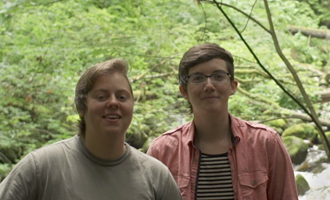 Edith and Heather
Edith and Heather
Port Moody
Edith and Heather living in Port Moody, in a townhouse they rent that sits on the border between dense housing developments and wild green mountain spaces. Edith works with kids as an occupational therapist, and Heather is studying to be a high school teacher. Both have been involved in environmental and social justice issues as activists, and are thinking about ways we can make change at the levels of politics, policy and government. For them, activism can mean many things – and can be as simple as having conversations the things that are important to you. Hear more from Edith and Heather in Chapter 6.
I dream about a world where making legislation that doesn’t consider the environment will be taboo. – Edith
Puneet, Tanya, David, Carolyn, Thomas, Leanne, James, Edith, and Heather all dream of a future where everyone can live a good, green life. They don’t underestimate the scale of the challenge. But each is finding ways to help make the future they dream about a reality. Here more about their vision in Chapter 7.